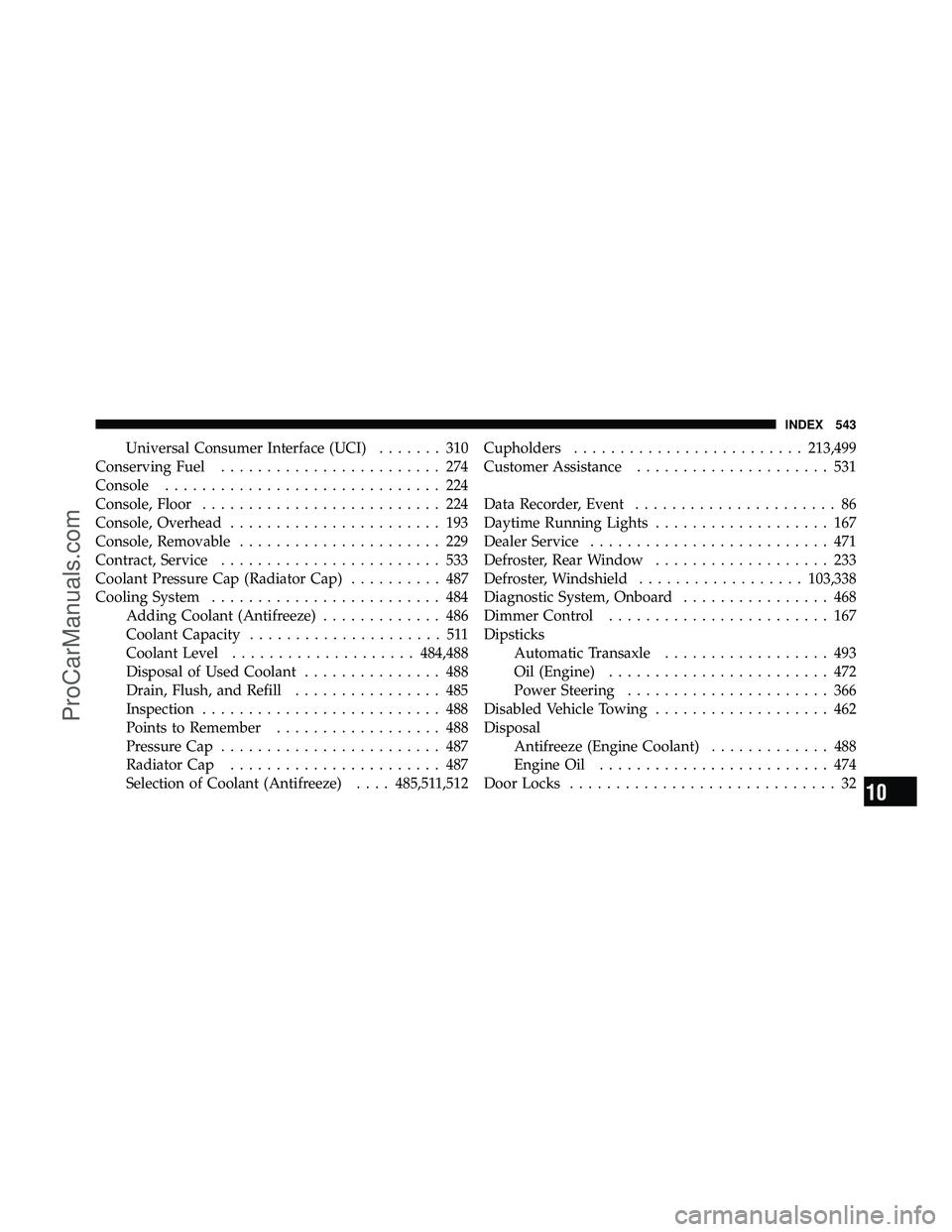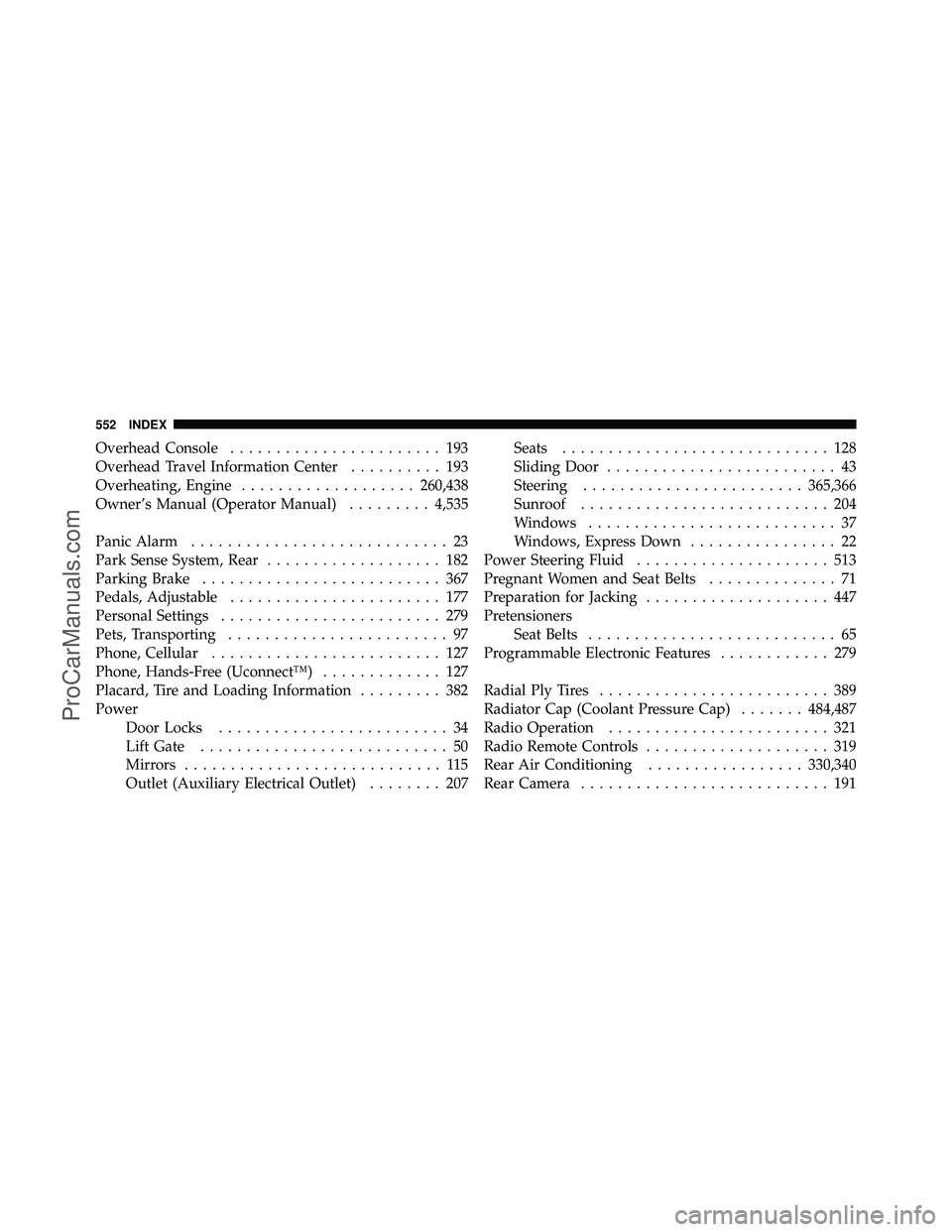2011 DODGE CARAVAN radiator
[x] Cancel search: radiatorPage 489 of 562

NOTE:Mixing engine coolant (antifreeze) types will
decrease the life of the engine coolant (antifreeze) and
will require more frequent coolant changes.
Cooling System Pressure Cap
The cap must be fully tightened to prevent the loss of
engine coolant (antifreeze), and to ensure that engine
coolant (antifreeze) will return to the radiator from the
coolant recovery bottle.
The cap should be inspected and cleaned if there is any
accumulation of foreign material on the sealing surfaces.
WARNING!
•The warning words “DO NOT OPEN HOT” on
the cooling system pressure cap are a safety pre-
caution. Never add engine coolant (antifreeze)
when the engine is overheated. Do not loosen or
remove the cap to cool an overheated engine. Heat
causes pressure to build up in the cooling system.
To prevent scalding or injury, do not remove the
pressure cap while the system is hot or under
pressure.
•Do not use a pressure cap other than the one
specified for your vehicle. Personal injury or en-
gine damage may result.
7
MAINTAINING YOUR VEHICLE 487
ProCarManuals.com
Page 490 of 562

Disposal Of Used Coolant
Used ethylene glycol-based engine coolant (antifreeze) is
a regulated substance requiring proper disposal. Check
with your local authorities to determine the disposal
rules for your community. To prevent ingestion by ani-
mals or children, do not store ethylene glycol-based
engine coolant (antifreeze) in open containers or allow it
to remain in puddles on the ground. If ingested by a child
or pet, seek emergency assistance immediately. Clean up
any ground spills immediately.
Coolant Level
The coolant bottle provides a quick visual method for
determining that the coolant level is adequate. With the
engine cold, the level of the engine coolant (antifreeze) in
the coolant recovery bottle should be between the ranges
indicated on the bottle.
The radiator normally remains completely full, so there is
no need to remove the radiator cap unless checking forengine coolant (antifreeze) freeze point or replacing the
engine coolant (antifreeze). Advise your service atten-
dant of this. As long as the engine operating temperature
is satisfactory, the coolant bottle only needs to be checked
once a month.
When additional engine coolant (antifreeze) is needed to
maintain the proper level, it should be added to the
coolant bottle. Do not overfill.
Points To Remember
NOTE:
When the vehicle is stopped after a few miles (a
few kilometers) of operation, you may observe vapor
coming from the front of the engine compartment. This is
normally a result of moisture from rain, snow, or high
humidity accumulating on the radiator and being vapor-
ized when the thermostat opens, allowing hot engine
coolant (antifreeze) to enter the radiator.
488 MAINTAINING YOUR VEHICLE
ProCarManuals.com
Page 491 of 562

If an examination of your engine compartment shows no
evidence of radiator or hose leaks, the vehicle may be
safely driven. The vapor will soon dissipate.
•Do not overfill the coolant recovery bottle.
•Check the engine coolant (antifreeze) freeze point in
the radiator and in the coolant recovery bottle. If
engine coolant (antifreeze) needs to be added, contents
of the coolant recovery bottle must also be protected
against freezing.
•If frequent engine coolant (antifreeze) additions are
required, or if the level in the coolant recovery bottle
does not drop when the engine cools, the cooling
system should be pressure tested for leaks.
•Maintain engine coolant (antifreeze) concentration at
50% HOAT engine coolant (antifreeze) (minimum)
and distilled water for proper corrosion protection of
your engine, which contains aluminum components.
•Make sure that the radiator and coolant recovery
bottle overflow hoses are not kinked or obstructed.
•Keep the front of the radiator clean. If your vehicle is
equipped with air conditioning, also keep the front of
the condenser clean.
•Do not change the thermostat for Summer or Winter
operation. If replacement is ever necessary, install
ONLY the correct type thermostat. Other designs may
result in unsatisfactory coolant performance, poor gas
mileage, and increased emissions.
Brakes
In order to assure brake system performance, all brake
system components should be inspected periodically.
Refer to the “Maintenance Schedule” for the proper
maintenance intervals.7
MAINTAINING YOUR VEHICLE 489
ProCarManuals.com
Page 504 of 562

CavityCartridge
Fuse Mini-Fuse Description
J14 40 Amp Green — Rear Window De-
fogger
J15 30 Amp Pink — Front Blower
J17 40 Amp Green — Starter Solenoid
J18 20 Amp Blue — Powertrain Control
Module Trans Range
J19 60 Amp Yellow — Radiator Fan
J20 30 Amp Pink — Front Wiper LO/HI
J21 20 Amp Blue — Front/Rear Washer
J22 25 Amp Natural — Sunroof ModuleCavity
Cartridge
Fuse Mini-Fuse Description
M1 — 15 Amp BlueRear Center Brake
Lamp/Brake Switch
M2 — — —
M3 — 20 Amp YellowSpare Fuse
M4 — 10 Amp RedTrailer Tow
M5 — 25 Amp NaturalInverter
M6 — 20 Amp YellowPower Outlet #1
(ACC), Rain Sensor
M7 — 20 Amp YellowPower Outlet #2
(BATT/ACC SE-
LECT)
M8 — 20 Amp YellowFront Heated Seat –
If Equipped
502 MAINTAINING YOUR VEHICLE
ProCarManuals.com
Page 544 of 562

Oil (Engine)........................ 474
Power Steering ...................... 366
Radiator (Coolant Pressure) ............. 487
Car Washes ............................ 494
Carbon Monoxide Warning ..............101,412
Cargo (Vehicle Loading) ................... 224
Cargo Compartment Luggage Carrier ..................... 234
Caution, Exhaust Gas ...................... 53
Cellular Phone ....................... 127,321
Center High Mounted Stop Light ............ 510
Chains, Tire ............................ 395
Changing A Flat Tire ..................... 439
Chart, Tire Sizing ........................ 378
Check Engine Light
(Malfunction Indicator Light) .............254,469
Checking Your Vehicle For Safety ............ 101
Checks, Safety .......................... 101
Child Restraint ...................... 87,88,89Child Restraint Tether Anchors
............... 91
Child Safety Locks ........................ 47
Child Seat .............................. 91
Clean Air Gasoline ....................... 408
Cleaning Wheels ............................ 496
Climate Control ......................... 321
Clock ............................. 287,296
Coat Hook ............................ 223
Coin Holder ........................... 224
Cold Weather Operation ................... 352
Compact Disc (CD) Maintenance ............. 320
Compact Spare Tire ...................... 390
Compass ........................ 262,265,277
Compass Calibration .................. 265,278
Compass Variance .................... 264,278
Computer, Trip/Travel .................... 276
Connector UCI .............................. 310
542 INDEX
ProCarManuals.com
Page 545 of 562

Universal Consumer Interface (UCI)....... 310
Conserving Fuel ........................ 274
Console .............................. 224
Console, Floor .......................... 224
Console, Overhead ....................... 193
Console, Removable ...................... 229
Contract, Service ........................ 533
Coolant Pressure Cap (Radiator Cap) .......... 487
Cooling System ......................... 484
Adding Coolant (Antifreeze) ............. 486
Coolant Capacity ..................... 511
Coolant Level .................... 484,488
Disposal of Used Coolant ............... 488
Drain, Flush, and Refill ................ 485
Inspection .......................... 488
Points to Remember .................. 488
Pressure Cap ........................ 487
Radiator Cap ....................... 487
Selection of Coolant (Antifreeze) ....485,511,512 Cupholders
......................... 213,499
Customer Assistance ..................... 531
Data Recorder, Event ...................... 86
Daytime Running Lights ................... 167
Dealer Service .......................... 471
Defroster, Rear Window ................... 233
Defroster, Windshield .................. 103,338
Diagnostic System, Onboard ................ 468
Dimmer Control ........................ 167
Dipsticks Automatic Transaxle .................. 493
Oil (Engine) ........................ 472
Power Steering ...................... 366
Disabled Vehicle Towing ................... 462
Disposal Antifreeze (Engine Coolant) ............. 488
Engine Oil ......................... 474
Door Locks ............................. 32
10
INDEX 543
ProCarManuals.com
Page 554 of 562

Overhead Console....................... 193
Overhead Travel Information Center .......... 193
Overheating, Engine ................... 260,438
Owner’s Manual (Operator Manual) .........4,535
Panic Alarm ............................ 23
Park Sense System, Rear ................... 182
Parking Brake .......................... 367
Pedals, Adjustable ....................... 177
Personal Settings ........................ 279
Pets, Transporting ........................ 97
Phone, Cellular ......................... 127
Phone, Hands-Free (Uconnect™) ............. 127
Placard, Tire and Loading Information ......... 382
Power Door Locks ......................... 34
Lift Gate ........................... 50
Mirrors ............................ 115
Outlet (Auxiliary Electrical Outlet) ........ 207Seats
............................. 128
Sliding Door ......................... 43
Steering ........................ 365,366
Sunroof ........................... 204
Windows ........................... 37
Windows, Express Down ................ 22
Power Steering Fluid ..................... 513
Pregnant Women and Seat Belts .............. 71
Preparation for Jacking .................... 447
Pretensioners Seat Belts ........................... 65
Programmable Electronic Features ............ 279
Radial Ply Tires ......................... 389
Radiator Cap (Coolant Pressure Cap) .......484,487
Radio Operation ........................ 321
Radio Remote Controls .................... 319
Rear Air Conditioning .................330,340
Rear Camera ........................... 191
552 INDEX
ProCarManuals.com